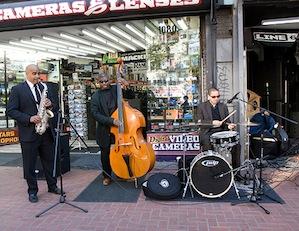Stanford Consecrates Bing Hall With Auditorium
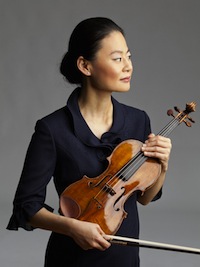
Photo by Timothy Greenfield-Sanders
Neither the birth or the death of Ludwig van Beethoven (1770–1827) can be made into a nice round figure in 2012-2013, but you wouldn't know that in the Bay Area. San Francisco Symphony's next season offers 11 works on five programs of "A Beethoven Exploration," and Stanford's new Bing Concert Hall is also going to town with Beethoven in the inaugural 2013 season.
"The Beethoven Project," with all nine Beethoven symphonies and five piano concertos, opens Jan. 18 and 20, with two of the composer's most often performed works, the "Emperor" Piano Concerto (with Jon Nakamatsu) and the Symphony No. 5. Jindong Cai is conducting the Stanford Symphony, adding a very appropriate Beethoven: The Consecration of the House Overture.
Additionally, Emanuel Ax performs Beethoven piano sonatas on Jan. 22 (adding a Chopin sonata for variety), followed by more orchestral Beethoven Project concerts.
Even when Midori appears, with pianist Özgür Aydin, the program has two Beethoven sonatas, one Bach and one Brahms. Yo-Yo Ma and pianist Kathryn Stott will play Stravinsky, Falla, Villa-Lobos, Piazzolla, Messiaen, and Brahms; and Laurie Anderson will join the Kronos Quartet for the West Coast premiere of a newly-commissioned work.
Variety is also represented by the St. Lawrence String Quartet (Haydn and Schafer quartets, Thuille Quintet with pianist Stephen Prutsman); Philharmonia Baroque (playing Baroque music), a Department of Music Showcase (program to be announced), South African singer Vusi Mahlasela, Portland's Cappella Romana; and so on.
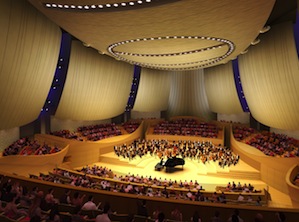
Bing Hall, still very much a construction site, is an 844-seat performance venue, opening in January 2013. The Monday season announcement also included introduction to Stanford Live, a new organization "with an expansive and inclusive approach to creating, presenting, nurturing, and celebrating the performing arts."
SFCV writer Lisa Hirsch attended the Monday press conference, and she asked if 14 Beethoven-focused concerts are programmed to help audience development. She reports:
Wiley Hausam, newly appointed managing director of Bing Hall, replied that the focus on Beethoven is explained by "the integration of Beethoven into Stanford's curriculum, student-driven programming, getting students into a concert setting who may not have heard classical music in such a setting, friends and family of students, ongoing exploration; the awakening of those things we feel when we hear such masterpieces."
See Hirsch's blog for additional reports and comments.
Ross McKee Finalists in Free Concert
The 15th annual Ross McKee Piano Competition finalists will perform in a free concert, at 7 p.m. on June 9, in the S.F. Conservatory of Music Recital Hall. Six Bay Area artists, ages 14 to 17, will compete for cash prizes to be awarded at the end of the evening.The musicians are Angela Li, 17, San José, a student of Erna Gulabyan of Mountain View; Catherine Xu, 15, San José, a student of John McCarthy of San Francisco; Hugo Kitano, 16, San Francisco, a student of Hans Boepple of San José; Agata Sorotokin, 14, San José, and Alice Zhu, 14, Cupertino, both also students of John McCarthy; and Brian Zeng, 16, Sunnyvale, a student of Haggai Niv of Greenbrae.
Student Showcase Has All the Right Moves
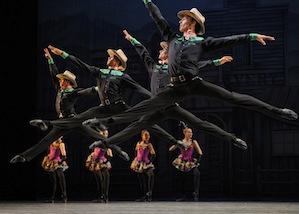
For those who missed it last week, a calendar-tickler for June 2013 and the next edition of one of most interesting — and most affordable — events of the San Francisco Ballet season.
It is the SFB Student Showcase: a combination of first-class dancing and the opportunity to be on the ground floor of discovering the stars of tomorrow. The Showcase is to ballet what Merola Program events are for opera. (About the price: $35 to $40 at Yerba Buena Center for the Arts and raising funds to support scholarship and financial aid programs.)
The event on Thursday was made even more special with the final curtain call when company artistic director Helgi Tomasson and the students paid an emotional tribute to departing associate director Lola de Avila, whose 13 years of work has resulted in the school's unparalleled excellence.
The evening begins with a school demonstration to Czerny Etudes, 39 dancers performing eye-popping brief solos and ensemble pieces.
In a La Sylphide excerpt that followed, Jessica Carter, Katerina Eng, and Miranda Silveira danced an impressive pas de trois, yielding to the corps and two superbly talented soloists, tall, elegant Emma Rubinowitz, and Wei Wang, who combines elegance with athleticism.
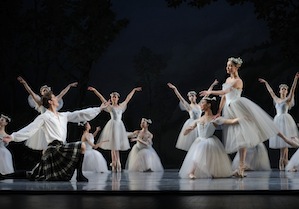
The two returned, along with 10 other dancers, in something "completely different": SFB Corps member Myles Thatcher's 2011 Spinae," to music by Phil Kline and Mary Ellen Childs. With flexible — no, undulating — torsos that must be seen to be believed, the young dancers brought the house down in this thoroughly modern and yet instantly accessible work.
Indefatigable Wang returned to partner Lauren Parrott in the climactic piece of the evening, one of George Balanchine's most amusing works, Western Symphony, to Hershy Kay's music. The first pas de deux showed off Brett Fukuda, a charming, petite, lightning-quick ballerina, dancing next to but not quite with Max Cauthorn.
In the fourth movement, Jeanette Kakareka and Alexander Reneff-Olson made better contact with each other, and in the finale, Eri Nikai and Hibiki Hatakeyama provided the ballet-show-biz apotheosis Mr. B. hath wrought.
San Francisco Ballet imports principals from the world over, but about half of the company consists of graduates from the school. Judging by this year's Showcase, that proportion may increase yet. And, without waiting for the future, you can have a great experience and a lot of fun in the here-and-now — next year.
S.F. Choral Artists' Prize Winners, Season-Closer
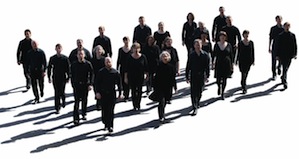 In its eighth year, San Francisco Choral Artists' New Voices Project competition for composers under the age of 30 awarded prizes to Katherine Saxon ("Speed and Perfection") and Daniel Galbreath ("There Will Come Soft Rains").
In its eighth year, San Francisco Choral Artists' New Voices Project competition for composers under the age of 30 awarded prizes to Katherine Saxon ("Speed and Perfection") and Daniel Galbreath ("There Will Come Soft Rains"). The two winning works will be part of the Choral Artists' season-closing concerts, June 9-16, titled "Poetry on Musical Wings" features 20 different composers "giving musical wings to sonnets, odes, riddles, and rhymes."
Galbreath says of the pairing of music and poetry: "I love hearing spoken words, and think it is hard to trump that kind of expressiveness. Music’s job is to take that quality and magnify it." Of the connection with Sara Teasdale's poem:
Back in junior high school, an instructor assigned Ray Bradbury's short story There Will Come Soft Rains, which centers on the Teasdale poem. The story has a quite unsettling sense of postapocalyptic serenity, which is intensely felt in the Teasdale poem as well.
The simply-worded couplets and nature-based imagery are at odds with the direction the text ultimately goes, especially in the last few stanzas when the cause of human beings' fate – and nature's utter lack of concern – are exposed. It creates a great deal of tension. I use some jazzier harmonies and off-kilter rhythms to underscore the blithe irony of the text, and of the natural elements in that text which are used to create the poem's didactic message.
For "Speed and Perfection," Katherine Saxon used text by award winning San Francisco Bay Area poet Jane Hirschfield.
The concerts, conducted by artistic director Magen Solomon, feature a rich and varied repertory, including works by Elgar, Paul Chihara, Frank La Rocca, Nils Lindberg, Peter Schickele, Randall Thompson, Paul Ayres, Schumann, Brahms, and others.
The 24-voice chorus, recent recipient of the Chorus America/ASCAP Award for Adventurous Programming, will open this final series of the season on June 9 at St. Mark’s Episcopal Church, Palo Alto; June 10 at St. Paul's Episcopal Church, Oakland; then on June 16 to St. Mark's Lutheran Church, San Francisco.
Public Funding For 'Public Artists'
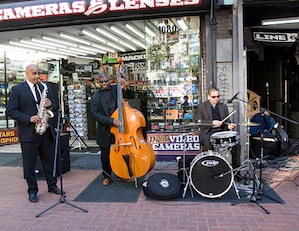
Photo by Lydia Gonzales
... funding for San Francisco-based musicians, dancers, comedians, actors, and public artists with imaginative projects that engage the public and appeal to the cultural makeup of the Central Market neighborhood. Grants range between $500 and $1,500.First-time applicants unfamiliar with the granting terrain can attend the Application Workshop on Thursday, June 14, 6 p.m. at 10 U.N. Plaza Building, Room 410 (at Market and 7th St).
All applications must be received in the Arts Commission office [25 Van Ness Ave. Ste 345, San Francisco, CA 94102] by Monday, June 25, 2012 (not a postmark deadline).
Colonials at the Big Jubilee Concert
 Yesterday's huge Queen's Diamond Jubilee Concert at Buckingham's Palace was conducted by an American, from Boston even. It was Boston Pops conductor Keith Lockhart, right at home in the pop mix of the event, which served up pretty much everything except a bit from the classical treasures of the Queen's domain.
Yesterday's huge Queen's Diamond Jubilee Concert at Buckingham's Palace was conducted by an American, from Boston even. It was Boston Pops conductor Keith Lockhart, right at home in the pop mix of the event, which served up pretty much everything except a bit from the classical treasures of the Queen's domain. So, instead of Purcell, Britten, et.al., there was Renée Fleming vying with Jessie J, Lang Lang (looking a bit like Liberace), Elton John, Paul McCartney, Stevie Wonder, Renée Fleming, Shirley Bassey (with Diamonds Are Forever, of course, but don't the Brits know diamond anniversaries take 75, not 60 years?), Tom Jones, Annie Lennox, Madness, Cliff Richard, Ed Sheeran, Kylie Minogue, and many more.
Almost four hours, it ended with firework, and ... Beethoven. Wouldn't Handel been more appropriate?
Here's the good news for those who missed the unexpectedly available free live video link: ABC-TV will present highlights of the concert today at 6 p.m. PDT.
Lockhart's Boston Pops will appear in several programs at Tanglewood's 75th anniversary season, June 22-Sept. 2, along with a spectacular lineup of musical guests. The Boston Symphony will release 75 free streams from Tanglewood's history — including concerts led by Koussevitzky, Bernstein, and Danny Kaye — one a day, free for 24 hours, after which they will be available for download for purchase.
Jubilee Explained
In this column's ongoing effort to be informative, we turned to The Official Website of the British Monarchy, and found:In the New Testament, Jesus presents himself as the One who brings the old Jubilee to completion, because he has come to "preach the year of the Lord's favour" (Isaiah 61: 1-2). In the Roman Catholic Church, jubilees began to be celebrated formally in 1300 AD and are years of forgiveness of sins and reconciliation. They are celebrated every 25 years. The most recent year of jubilee was 2000.Royal Jubilees celebrate significant periods in monarchs' reigns and the national life. Few British monarchs have achieved reigns of 50 years, and Golden Jubilees are very rare. There are few records of how if at all — Henry III, Edward III, and James VI and I celebrated their 50-year milestones.
The first British monarch to mark 50 years on the throne in a significant way was George III, followed by Queen Victoria. The Queen had Silver Jubilee celebrations in 1977, when she marked 25 years on the Throne — her Silver Jubilee.
False Alarm: 'All Microphones, All the Time'
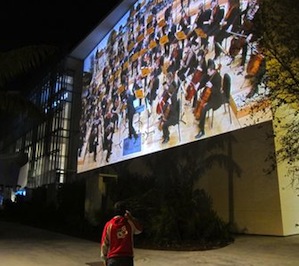
My amplification-allergic eyebrows went way up seeing that manufacturers of DPA microphones are proud to say that MTT's New World Symphony "relies on DPA Microphones 4023 compact cardioid microphones and 4028 compact wide cardioid microphones for all performances at the New World Center."
Further explaining the 21st century variety of "live music," the announcement says "For an orchestral concert, the DPA mics used include the 4023 or 4028 for the wind instruments and additional 4023s for spot mics when needed."
Is the resulting amplification used only for projection in the orchestra's innovative WallCasts and broadcasting/recording purposes or are those mics doing the job for the audiences in the concert hall too? If not yet, how much longer before concert halls and opera houses all make use of...
... mics hidden as much as possible. Getting good sound from the choir was important, but having mics not being seen by the cameras was also a priority. Since the DPA mics are black, as is the Flamingo hardware used with them, we were able to position them as needed while making sure it did not become an issue for the director of the show.
OK to Shout in the Concert Hall, Even When There is No Fire?
I found myself a bit preoccupied — as I believe are many classical concert goers — by the imposing restrictions of ritual behavior on offer: all the shushing and silence and stony faced non-expression of the audience around me, presumably enraptured, certainly deferential, possibly catatonic; a thousand dead looking eyes, flickering silently in the darkness, as if a star field were about to be swallowed by a black hole.So writes Brooklyn Philharmonic CEO Richard Dare in a Huffington Post article very much worth reading in its entirety.I don't think classical music was intended to be listened to in this way. And I don't think it honors the art form for us to maintain such a cadaverous body of rules.
Following up this column's Beethoven motif, here's just one Dare passage, invoking the noisy past of classical music:
To his contemporaries, the sheer primal suspense in the Third was deliberately jacked up to such an unbearable degree that by measure 394 the first horn famously goes berserk, acting out the listener's agony of expectation by breaking in on the violins prematurely.So unprecedented and unruly was this bold psychological stroke that it was at first mistaken, even by the composer's close friends, for a sort of prank. His pupil Ferdinand Ries, thinking a blunder had been made, cried out, "Can't the damned horn player count?!" for which he came pretty close to receiving a sharp box on the ear.
The Other Mary Magdalen Round Up
John Adams' new work, which premiered in Los Angeles last week, is being reviewed by Tim Mangan in this edition of SFCV, and Lisa Hirsch's blog carries a full list of responses:Joshua Kosman in the Chron, quotation corrected ("resourceful and sprawlingly dynamic score," "fitting counterpart [to El Nino]"); Zachary Woolfe in The New York Times ("big and ambitious, churning but ultimately limp, with moments of beauty among the longeurs").Mark Swed in the Los Angeles Times notes that Adams' 90-minute commission turned into 135 minutes. I'm having problems parsing this review, because Swed calls it a masterpiece but doesn't say why. Alex Ross does not have a full review yet, but on his blog says "some of the strongest — and also some of the strangest — music of the composer's career."
Brian Lauritzen of On the Air ("big and important"), Robert D. Thomas at Class Act ("very important, stunningly performed"), Brian at Out West Arts ("After two hearings, I'm still not sure if the piece is utter genius or something decidedly less memorable. But I do feel certain that this is a major step in a new direction for Adams.")
KDFC is Back in the South Bay
KDFC-FM, whose transition to public classical music radio is a work in progress, will re-establish its presence in the South Bay on June 15, transmission of signal at 104.9 originating from the southeast side of San José, reaching into Santa Cruz and Monterey.
Coverage maps, somewhat optimistic, show the station can now be heard in San Francisco, Oakland, Berkeley, and Marin (90.3), parts of the East Bay and Wine Country (89.9), Ukiah-Lakeport (92.5), and Los Gatos (90.3).
Merola/Adler Alumni Triumphs
Tenor David Lomelí
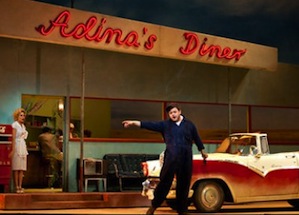
Lomelí is making his Glyndebourne debut tomorrow as Rodolfo in La Bohéme. Karen Ames, his publicist and mentor, writes from the Saturday dress rehearsal there: "David sang beautifully and seemed full of joy and confidence. I think this will be another breakout performance for him like Elixir was in London." (Last year, Lomelí's New York City Opera Elixir was a big success as well.)
Tenor Noah Stewart
NPR broadcast a program Sunday morning about the burgeoning career of Stewart, as he became "the first black singer to hit No. 1 on the classical music charts in the U.K.," with Noah.
Tenors Stuart Skelton and Brian Hymel in for Jonas Kaufmann
In a strange sequel, two San Francisco Opera products replaced Jonas Kaufmann in two different productions: Skelton sang Siegmund in a Metropolitan Opera Die Walküre (where alumna Deborah Voigt sings Brünnhilda), and Hymel is stepping in Kaufman's role as Enée in the Royal Opera's Les Troyens, beginning June 25, and including the Proms performance on July 22. The latter will be available for live streaming.
Soprano Laura Claycomb
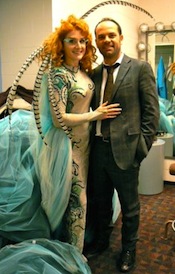
Unlike some successful singers who don't bother mentioning the Merola/Adler experience when they become stars, Claycomb — who has just starred in the San Francisco Symphony's Barbary Coast program — is fiercely loyal to the program. In a long, fascinating interview last year with Opera Warhorses, Claycomb said:
Merola has been described as "opera boot camp" by Dolora Zajick. It is very intense, and I made the schedule even more intense by staying upstairs in the ballet studio every night my first summer, trying out different things technically until they’d kick me out of the building. It was there that I started to really access the tip top of my voice. I was very inspired by all the "big girls" in Merola who had graduate degrees from famous conservatories and seemed to already know everything. They had rock-solid high E’s and D’s, and I had never really ventured up there for long. I wasn’t even legal to drink yet, for goodness’ sake! But I was covering Gilda, so I needed a good high E for the end of the vendetta. So I practiced at night in the ballet studio....
I don’t even know where to start about my Merola experience. I felt like I was a little remedial at first because everyone else was at least 3-5 years older than me, some more... and most of them seemed to be "in the know" about what programs were the best, who were the hot teachers, the hubbub from New York, etc. They were all very savvy. Many already lived in New York.
I had just come from my university in my hometown [Dallas]. My first weekend in San Francisco, there was all this commotion outside the window at my host’s house, and I opened the curtains to see a huge line of floats with flamboyant drag queens on them. I lived on Dolores Street and it was where they lined up the Gay Day Parade. So, my Merola experience educated me on many fronts ...
'Spirit of the Garden' in the Conservatory of Flowers
The quartet Rose & the Nightingale performs a concert on June 9, dealing with the subject of gardens through poetry and song in an appropriate venue: the Conservatory of Flowers in Golden Gate Park.
The ensemble making its West Coast debut is a New York City-based quartet of vocalists and instrumentalists, blending world music, folk, and jazz improvisation. "The Spirit of the Garden" integrates poetry about gardens and nature with the lyrics of a cycle of original songs and improvisations created in collaboration with San Francisco poets Evan Karp and Silvi Alcivar.
The new compositions by Karp and Alcivar, inspired by the Conservatory of Flowers, receive their premiere at the event, the first stop on a nationwide concert tour to botanical gardens throughout the country.
The ensemble consists of Jody Redhage (cello, vocals, compositions); Sara Caswell (violin and mandolin); Laila Biali (piano and vocals); and Leala Cyr (vocals, trumpet and percussion).

